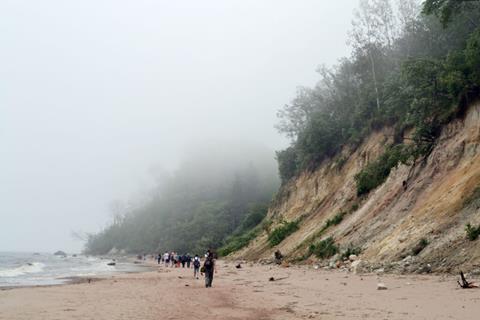The Ida-Viru region in Estonia shares a 77km eastern border with Russia. The region’s nascent film industry was struck by the double blow of the pandemic, then the 2022 Russian invasion of Ukraine. Two years on from the latter and with the war still ongoing, Ida-Viru is looking to bounce back.
Last month funding from the European Union’s Just Transition Fund was confirmed for a €15m film studio in the regional capital of Johvi, with two soundstages – one at 21,500 sq ft, the other at 13,000 sq ft. Construction is scheduled to start this summer, with a planned finish date in autumn 2025.
“The hope is it’s attractive for a younger generation and also on an international level,” says Piia Tamm, coordinator of the Ida-Viru film fund, established as Estonia’s first regional film fund in 2013. Tamm says the new studio will also contain photography, sound engineering and post-production facilities. Construction is also underway on an airport near Narva, the region’s largest town, with flights servicing Tallinn as well as Helsinki.
It is not just studio space that can attract productions to the Ida-Viru, Tamm believes. The Fund has a rebate of up to 40% of local spend, up to a €200,000 maximum – with no minimum spending requirement and no project restrictions.

The region benefits from a diversity of locations, from the vast disused Krenholm manufacturing plant; through the Narva canals that freeze over in winter; to both sandy and stony beaches on the northern coastline. There are national parks in the south of the region; and Sillamae, a ‘secret’ town that was hidden from Soviet maps due to uranium production activities.
Ida-Viru is yet to secure an international project on the scale of Christopher Nolan’s Tenet, which filmed partly in the Estonian capital Tallinn in 2019. Key productions to date have included Rain Rannu’s cryptocurrency comedy Free Money last year, Aki Louhimies’ Finnish-Estonian co-production thriller Omerta 6/12 in 2021, and Finnish-Swedish co-production The Eternal Road in 2017.
In recent years the region has looked to make the most of the international visitors attending November’s annual Tallinn Black Nights Film Festival, both through excursions from Tallinn to the region; and through Kino Film Festival (KinoFF), a spin-off regional event taking place at the same time in two cities in Ida-Viru.
“The idea of KinoFF is to attract and build the infrastructure for a film industry,” says Jana Budovskaja, who runs the event as well as being a tech entrepreneur. “To have more film people come over, and also to show the film industry as a possible place to work.”
Budovskaja also runs development programmes providing a pathway for those not currently in the industry, of all ages. “A lot of people in their middle age, they decide ‘it was my dream to make a film’ – and they’re making it!”
Split identity
The February 2022 invasion had a severe impact on production in the region. “We had worked more than eight years when the war struck; then everything disappeared,” said Tamm. “So we started to build up again.”
With almost three-quarters of the population of Russian ethnic origin, Tamm sees Ida-Viru’s split Euro-Russian identity as an opportunity. “It’s interesting for filmmakers that they are so close [to Russia],” she says. “We’re not part of the Russian state; but people here know Russian culture, and speak Russian. If people want to do such films here, we have the architecture, cities, and people who know this field well.”
Both she and Budovskaja are keen to emphasise Estonia’s membership of NATO, which they say makes the region as secure as any other in the bloc. “I hope everybody knows it is a safe area,” says Tamm. “It is no more dangerous than filming in the UK, because missiles can fly very far away,” says Budovskaja. “If Russia decides to do something, then it doesn’t matter where we are.”
The invasion has had no effect on productions’ ability to secure insurance, says Budovskaja. Tamm says the only notable change since the war has been a ban on the use of drones near the border.

Another effect of that conflict has been the arrival of “several thousand” Ukrainian refugees in the region, according to Budovskaja – many of whom have worked on local productions. “They come with extra knowledge, because there was a lot of film production in Ukraine,” she says. “These people are a help to our region.”
Film has even been a unifying force between Estonian and Russian communities – exemplified by the two executives themselves, with Tamm of Estonian origin and Budovskaja a native Russian. “When we work together, everything is fine,” says Budovskaja of the two communities. “There are still people in Narva and Ida-Viru who are pro-Russian. But they don’t want to work in films. There is no problem in the creative industry community.”
Tamm attends Cannes each year with the Estonian Film Institute; and to increase awareness of Ida-Viru as a viable production region, has made trips to locations event Focus London. She recognises Ida-Viru is a small industry, but one with big goals; her dream filmmaker to shoot in the region would be Steven Spielberg.
“We want to be part of Europe, of all the world,” says Tamm. “The people here are very warm, they want to be partners for filmmakers.”






![The Brightest SunScreen[Courtesy HKIFF]](https://d1nslcd7m2225b.cloudfront.net/Pictures/274x183/3/5/0/1448350_thebrightestsunscreencourtesyhkiff_312678.jpg)



















No comments yet